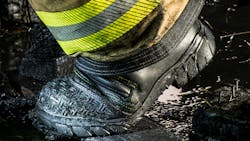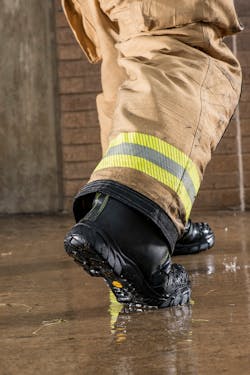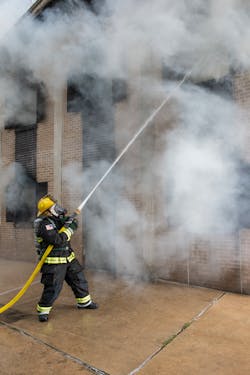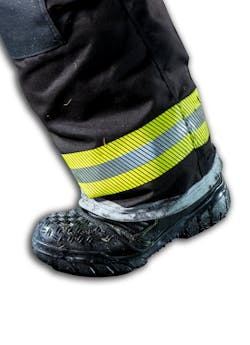Firefighting boots sometimes seem to be taken for granted by our profession, but they’re an important piece of the ensemble. Consider how important your regular shoes are to you, how much time that you spend to find comfort, functionality and, in certain types, protection.
Firefighting boots must provide protection from all of the hazards that we encounter: flame, heat, cold, smoke, water, hazardous fluids, penetrating objects, falling objects, etc., but also provide comfort, support and function. Just because a make of boot meets NFPA requirements doesn’t mean that it’s right for you. Feet come in variations, including length (size), width, and flat or arched, so getting the proper fit can be challenging. Furthermore, like in the real world where men and women wear different types and fits of shoes, women firefighters should get the same consideration. You should be sure to build that into your evaluation process, bid specification and contract language.
Why are you looking for a new/different boot? What’s your needs assessment?
When the question is posed to them, firefighters most likely will say comfort is the first concern. Your answer could include: the current contract is about to expire; you want to investigate new technology and design; you have concerns about durability issues; you incurred foot or ankle injuries while wearing your current boots; you are having penetration issues with the footplate; or you just aren’t happy with your current boots.
One can’t overstate the importance of forming a committee that will produce one or more firefighting boots experts. Part of this is to have a member(s) search the internet, view YouTube videos and visit other fire departments’ websites (no matter the department’s location) to see whether they posted about a purchase of boots. Testing and/or certification organizations can be a source of information, as can, of course, boot manufacturers.
As in the case of other components of PPE, boot manufacturers should be contacted to visit your location to show you their lines. A problem that can arise for departments that have a small number of members is a reluctance on the part of manufacturers to visit to display their wares. To counter this: Team up with nearby departments to increase the size of the potential purchase order. Six fire departments that require 60 or more pair total might get manufacturers thinking.
Wearing boots that are being evaluated for purchase during calls can’t be considered the only method for carrying out an assessment—even if the same firefighter wears the boots. If you think about it, there’s no way to guarantee that the pairs of boots that are being evaluated will be on the fireground a certain number of times or be put through numerous ladder climbs, vehicle extrications, dumpsters, vehicle fires, etc., from one shift to the next, from one week to the next.
Boots that are under consideration and being evaluated by a department should be worn over an extended period of time, although how much lengthy that period of time is likely depends on how quickly that you/your department must produce the recommendation or selection.
Boot evaluations also should be done in full PPE—this includes SCBA—and on incidents that occur beyond the fireground. Such an approach will give you/your department a look at how the boots interface and move with the ensemble in a physical evolution.
Access to a burn building can permit evaluation of the thermal protection and the movement of a boot that’s under evaluation in a more regulated situation. (Crawl down a hallway as if simulating a search and rescue.)
Keep an eye on the pull straps and the top seams of the boot for wear.
Make sure that you lay out your department’s parameters for evaluating with the makers of the boots that you want to assess. For example:
“The evaluation for structural firefighting boots is planned to begin no later than (date) and conclude upon completion, to properly assess all aspects of boot: fit, function and durability.
Note: The phrase “conclude upon completion” doesn’t tie you into an end date, so as to account for delays and unforeseen issues.
- All manufacturers that produce their products in the (United States, etc.) are invited to participate. The following parameters will apply to all products and all participants:
- A minimum of (number) pairs of each style shall be submitted. Multiple styles may be submitted.
- Of the (number) submitted pairs of boots, one of the pairs that’s randomly selected may be used for destructive testing and examination internally by (Name) Fire Department.
Note: It’s recommended that you cut the boot(s) in half or have the manufacturer bring a cut-away of the boot(s).
- All products that will be included in (Name) Fire Department’s evalaution must meet all of the current requirements of NFPA 1971: Standard on Protective Ensembles for Structural Firefighting and Proximity Fire Fighting.
- Participating manufacturers will ensure that correct sizing is provided for each person who is picked by (Name) Fire Department to wear boots for the purpose of evaluations.
Note: When you acquire boots for evaluation, try to do so for personnel who are on the low and high end of the size scale and include women firefighters.
- Participating manufacturers must ensure that training is provided to meet any applicable aspects of NFPA 1851: Standard on the Selection, Care, and Maintenance of Protective Ensembles for Structural Fire Fighting and Proximity Fire Fighting.
- (Name) Fire Department prefers the protective footplate to be constructed out of the same material that’s specified by the department unless otherwise allowed by the department. The committee will review and may accept into the evaluation alternative materials or technology that is proven to resist penetration by a pointed object.
Note: The newer generation of composite footplates can resist a nail from penetrating. You should ask before your department agrees to accept a product to test whether the manufacturer’s boot is constructed with a composite footplate for protection from penetration.
- A boot manufacturer must present the appropriate NFPA 1971 Technical Data Package for its product(s) before the manufacturer is accepted to participate in the evaluation.
- Any style, seam, stitching, design concept and innovation that’s included as part of the current (Name) Fire Department specification takes precedent in the construction of the boots that are submitted for evaluation unless an approved alternative is allowed by (Name) Fire Department.
About the Author




